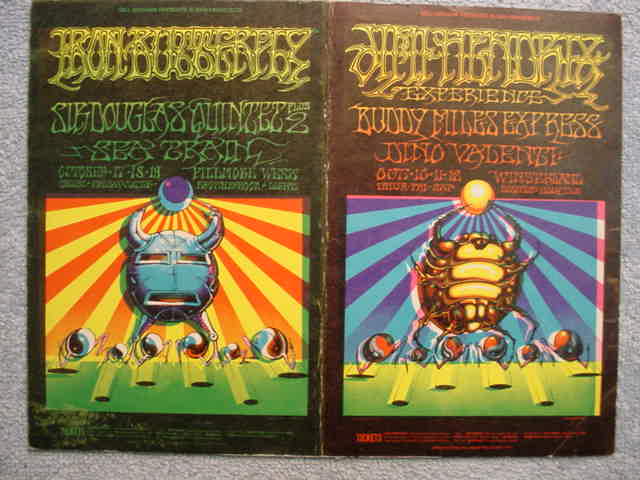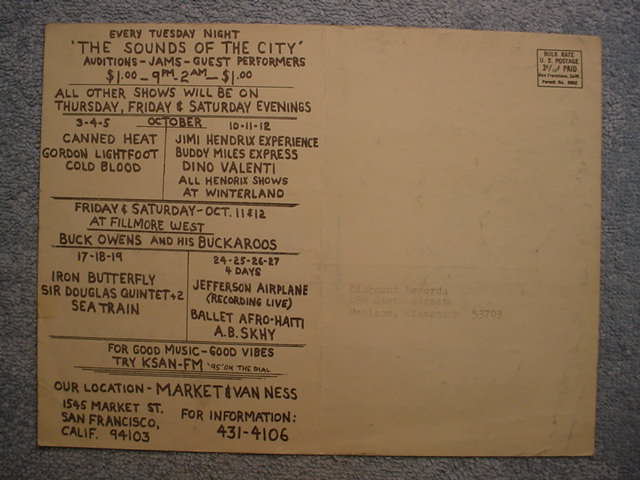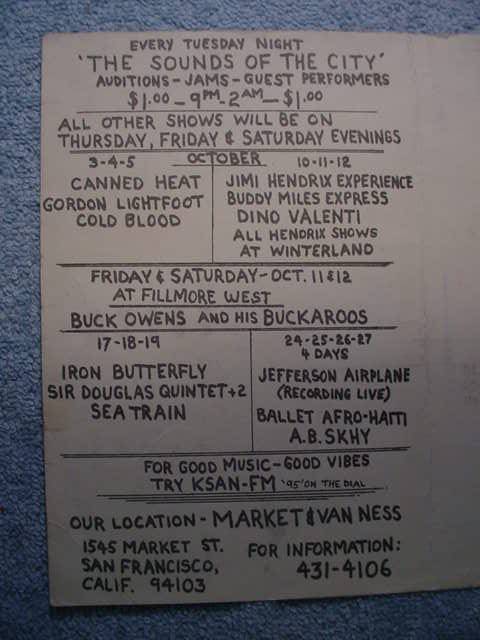October 18, 1968
SIR DOUGLAS QUINTET + 2
IRON BUTTERFLY
SEA TRAIN
location: Filmore West
place: San Francisco, CA
country: USA
This is the BG -140 & 141 postcard.
BG-140 details (has calendar on the back):



Rick Griffin Bio:
Richard Alden Griffin was born near Palos Verdes, California on the 18th of June 1944. His father, James, was an engineer (who had briefly worked as an animator for Disney) and an amateur archaeologist in his spare time. As a boy, Rick accompanied his father on digs in the Southwest, where Rick was exposed to the Native American and ghost town artifacts that were to influence his later work.
Rick was taught to surf by Randy Nauert at the age of 14 at Torrance Beach. The pair had met at Alexander Flemming Jr. High and were to become lifelong friends, Rick producing much of the artwork for Randy's future band, the Challengers.
At Nathaniel Narbonne High School in the 50's Rick began copying images from Mad Magazine and then developed his own style of surf doodles. Rick's friends would pay him 50¢ for an original piece penned on their shirts. Rick was also interested in Hot Rod cars and motorcycles, their decoration being amongst his earliest professional work.
As a contributor to the underground comix movement, his work appeared regularly in Zap Comix. Griffin was closely identified with the Grateful Dead, designing some of their best known posters and record jackets.
Randy Nauert introduced Rick to John Severson at a screening of "Surf Fever" at Narbonne High telling John that he should hire Rick for his magazine. Rick had already done artwork for Greg Noll (decorating Noll's early price lists), the Illustrated Surfer's Dictionary, and Bing. Soon he was designing posters for surf movie screenings and advertising spot illustrations for Hermosa Beach’s Greg Noll Surf Shop. Soon after leaving Palos Verdes High School, Rick became staff artist at Surfer Magazine. After high school, Griffin became staff artist at Surfer Magazine, where the comic strip character, Murphy—the little gremlin he had created—became an iconic image integral to the California surf scene.
Adopted by many as a mascot, the little Gremlin (thought by some to have been the personification of Rick), soon became integral to the Californian surf scene. Rick parted company with Surfer in 1964.
Planning to immigrate to Australia, Rick hitched a lift toward San Francisco. After falling asleep, he awoke to find the car swerving from side to side with the driver laughing maniacally. The vehicle went out of control and Rick later recalled that the last thing he remembered was flying through the air watching his cheap suitcase hitting the ground and splintering into a thousand pieces. The first thing he heard when he finally regained consciousness was someone reading Psalm 23 "Yea, though I walk through the valley of the shadow of death...” This proved to be a major factor in Rick's later conversion to Christianity.
Rick's left eye was dislocated in the accident (perhaps the inspiration behind the disembodied eye in his subsequent work), and he sustained lasting facial scarring. Subsequently Rick changed not only his appearance, (he grew a beard and sported an eye-patch), his art also became more sophisticated and the characteristic fluid lettering style emerged.
In 1964, while attending Chouinard Art Institute, Griffin met his future wife, Ida Pfefferle, and fell in with a bohemian art gang/jugband group that had recently arrived in Los Angeles from Minnesota, known as the Jook Savages. Griffin played the one-string zither, began to smoke weed, grow his hair, and dress differently. In mid 1965, he shelved the Murphy character indefinitely and began the “Griffin-Stoner Adventures,” in which a more accurate self-caricature—paired with a foil based on Surfer Magazine photographer Ron Stoner—wandered the globe supposedly sending coded dispatches to the magazine from the frontlines of a rapidly evolving surf culture.
His time at Chouinard Art Institute, (now Cal Arts), was to shape Rick's future life. Not only did he meet fellow artist and future wife Ida Pfefferle, but in 1964 he became involved with the Jook Savages a group of artist-musicians. After taking time out for a Mexican surf trip, Rick and Ida met up with the group in San Francisco in late 1966, the two living initially in their van.
While Griffin was in demand as the illustrator for surf-related commercial enterprises, he was also drawn to the emerging counterculture. He and his friends attended Ken Kesey’s Acid Test in riot-devastated Watts where they drank the Kool-Aid. Ida, who had moved to the Bay Area to give birth to Rick’s daughter, Flaven, started sending Griffin postcard versions of the new posters emerging from the growing Haight-Ashbury ballroom scene. Griffin had come across the year-old “Seed” (AOR-2.2) poster advertising The Charlatans at the Red Dog Saloon in Virginia City, Nevada. Its combination of Old West and circus poster motifs rendered with handmade variations on old typefaces caught Griffin’s attention and led him to the scene at the Red Dog Saloon.
Frustrated with Chouinard and Surfer Magazine’s censorship of his Griffin-Stoner strips, Griffin folded up shop and split to spend the summer of 1966 in Mexico surfing. Griffin later reunited with Ida and relocated to San Francisco’s Haight-Ashbury, where the Jook Savages had been offered a group show of their artwork at The Psychedelic Shop. Rick Griffin’s first San Francisco rock poster was for the Jook Savages Art Show at the “New Improved Psychedelic Shop,” and it led directly to an invitation to design a poster for the Human Be-In in 1967 in Golden Gate Park, advertised as the "Gathering Of Tribes", showing a guitar toting Indian on horseback announcing a jamboree integrating the clans of the Berkeley radical stronghold, the lingering North Beach Beat scene, and the blossoming hippie community.. It was this event that kicked off the Summer of Love. As the Haight-Ashbury scene developed, Rick's work was in high demand.
More than 20,000 tribe members assembled on the polo field in Golden Gate Park to hear Allen Ginsberg, Gary Snyder, Lenore Kandel, Timothy Leary, and Jerry Rubin, and dance to the music of the Grateful Dead, Quicksilver Messenger Service, Sir Douglas Quintet, Big Brother & The Holding Company, and Jefferson Airplane. The poster so perfectly captured the vibe of the event that it instantly became iconic. Griffin’s work was also featured in the January Human Be-In edition of the S.F Oracle—released to coincide with the event—with a spectacular centerfold illustration for Allen Ginsburg’s “Renaissance or Die.”
Chet Helms and Bill Graham both recruited Griffin to work on their promotions. From March of 1967 through November of 1968, Rick Griffin produced more than two dozen posters for the Family Dog and Bill Graham, plus almost as many commissions and projects done for the Berkeley Bonaparte poster company (in which he was a partner) and for out-of-town clients. Griffin’s first official Family Dog poster hit the streets in March 1967.
Drawing on influences as diverse as Native American culture, the Californian surf scene and the burgeoning hippie movement, he incorporated beetles, skulls, surfing eyeballs, vivid colors and wild lettering into his art.
Rick produced a series of ground-breaking posters for Chet Helms, a producer of The Family Dog collective and Bill Graham who staged events at the Avalon Ballroom and the Fillmore Auditorium respectively. He made posters for legends such as Jimi Hendrix, Albert King and the Grateful Dead, the logo for Rolling Stones magazine, and many album sleeves; perhaps the most well-known being the Grateful Dead's Aoxomoxoa.
Along with Alton Kelley, Stanley "Mouse" Miller, Victor Moscoso and Wes Wilson, Rick became known as one of the "Big Five" of psychedelia. In 1967 they founded the Berkeley-Bonaparte distribution agency to produce and sell psychedelic poster art. He oversaw the lithography, ensuring a flow of quality artwork by himself and other leading lights, destined to grace the walls of the enlightened to this day. The famous 'Flying Eyeball' poster ranks as one of the most important of the time and is sought after by fans and modern art museums alike.
Although at the vanguard of the psychedelic art movement Rick still produced comic art true to his roots. His work can be found in Zap, Snatch and Tales From The Tube.
Early in 1967, Griffin was commissioned to design the logo for a new magazine called Rolling Stone. By July 17, the Big Five (Wilson, Kelley, Mouse, Moscoso, and Griffin) were the subject of the solo “Joint Show” at the uptown Moore Gallery, which generated huge opening-night crowds and massive publicity, including a review in the San Francisco Chronicle. On September 1, Griffin (alongside the Big Five, except Mouse), was featured in a LIFE cover story called “The Great Poster Wave.”
As if that were not enough, Griffin was Robert Crumb’s choice to contribute to the second issue of Zap Comix. Griffin and Moscoso had already been toying with the idea of producing a comic book, and Griffin’s famous mutant Morning Paper funny pages poster (FD-89) is said to have inspired Crumb’s Ultra Super Modernistic Comics in Zap #1. Griffin contributed heavily to Zap #2.
When Rick moved back to Southern California in 1969 and settled eventually in San Clemente, John Severson asked him to design a poster for his latest film Pacific Vibrations, and to appear in it. Months later Severson was presented with a masterwork.
Rick and Ida's daughter Adelia was born whilst Rick was working on the piece and both mother and unborn child are featured in the poster. Rick did more work for Surfer and also found time to create the Man From Utopia comics.
In the 70's Rick became a Christian and his work took a radical change of direction. He produced the Illustrated Book of Saint John and later created work for the Calvary Chapel in Costa Mesa. The Chapel was affiliated with Maranatha! Music and hired Rick as art director to produce album covers, posters and flyers for the growing Christian music scene.
Rick travelled to Europe in 1976 with his friend and agent Gordon McClelland to exhibit his work in Amsterdam, London, and Sunderland in the north of England. On their return to California McClelland wrote Rick's biography, Rick producing the cover art.
In the 1980's Rick's work included a logo and cover art for English rockers The Cult, notably "Soldier Blue", designed in 1987 for an aborted single release and not to see the light of day until it was used as a template for "Rare Cult" thirteen years later.
As a perfectionist Rick put 110% into every piece he produced no matter how large or how small, but he was never a businessman and according to daughter Flaven never considered that people would try to rip him off. Murphy's last appearance was in 1987 pouring over druid runes, suggesting perhaps, that the artist was re-evaluating his life once more. At this time Rick was surfing in the cold water at Mystos, north of San Francisco.
At noon on 15th August 1991 in Petaluma, California Rick phoned Robert Beerbohm's gallery from a grocery store payphone to hear that a painting had just sold for $1800. On his way back to his house on Stadler Lane he was thrown from his Harley-Davidson Heritage Softail motorcycle when he collided with a van that suddenly turned left as he attempted to pass it. He was not wearing a helmet and sustained major head injuries. He died three days later on August 18 in nearby Santa Rosa Memorial Hospital, at the age of 47.
His loss cannot be over-estimated, a true visionary and outstanding talent, he enhanced our lives in so many ways.
Rick Griffin's last published work was printed in the San Francisco magazine, The City, shortly before his death; a self-portrait of the man at Heaven's Gate, pen and ink in hand.
Victor Moscoso Bio
Victor Moscoso (born 1936 in Oleiros, Spain) is an artist best known for producing psychedelic rock posters/advertisements and underground comix in San Francisco during the 1960s and 1970s.
Moscoso was the first of the rock poster artists of the 1960s era with formal academic training and experience. After studying art at Cooper Union in New York City and at Yale University, he moved to San Francisco in 1959. There, he attended the San Francisco Art Institute, where he eventually became an instructor.
At a dance at the Avalon Ballroom, Moscoso saw rock posters and decided that he could "make some money doing posters for those guys." In the fall of 1966 he began designing posters for the Family Dog and also produced posters for the Avalon Ballroom. Under his own imprint, Neon Rose, he did a series for Matrix, a local night spot. Moscoso's style is most notable for its visual intensity, which is obtained by manipulating form and color to create optical effects. He relied on innovative optical effects that gave his psychedelic posters a unique "vibrative" quality. Moscoso's use of intense color contrasts and vibrating edges and borders was influenced by painter Josef Albers, his teacher at Yale. Given Moscoso's artistic sophistication, it is not surprising that he was the first of the rock poster artists to use photographic collage in many of his posters. Jeffrey Morseburg writes in his biography that Moscoso distilled the understanding of color relationships that he learned from Joseph Albers into his poster design work. He would create an optical effect in the viewer by alternating deeply saturated primary colors. The juxtaposition of colors would create the illusion of the poster moving back and forth in space. Moscoso used more conventional typefaces than some of the other designers, usually letters with large serifs, but he bent and twisted them into interesting shapes making them difficult to read.
Moscoso was among the most gifted and influential artists to emerge from the '60s counterculture, pioneering not only the psychedelic concert poster designs made famous during San Francisco's Summer of Love, but also making his mark in underground comix. Alongside Rick Griffin, Wes Wilson, Stanley Mouse, and Alton Kelley; the “Big Five”, with whom his work was celebrated during the famed 1967 "Joint Show" -- Moscoso became one of the most famous of the psychedelic artists to surface during the mid-'60s, due to his provocative work for the Family Dog's dances at the Avalon Ballroom, and his Neon Rose posters for the Matrix earning international attention. By 1968, he had turned his focus to underground comics and storytelling, becoming one of the contributors to Robert Crumb's infamous Zap series; he also gained renown for his cover art for performers like Jerry Garcia, Bob Weir, Herbie Hancock, and David Grisman. Moscoso additionally designed countless t-shirts and billboards, later winning a pair of CLIO awards for his animated advertising projects; he also worked in music video.
There’s always some education to be had from looking at comics by artists who are better known for their work in other media. Victor Moscoso is one of two members of hippie-era San Francisco’s legendary Zap Comix collective whose work on rock concert posters is arguably more notorious and influential than his comics. (Rick Griffin accompanies him in this category.) That isn’t to say, however, that Moscoso’s comics have wielded anything less than a tremendous influence over the past few decades, despite the fact that they remain somewhat under-discussed. Moscoso brought color printing to the medium’s underground, did work in Zap that anticipates the most adventurous of today’s experimental comics, and brought a cubist-inflected fine art sensibility to his pages that echoes in the work of cartoonists from Gary Panter to Art Spiegelman.
But the most striking thing about Moscoso’s comics work is just how effectively he was able to translate the action and effect of his stroboscopic posters into sequential form. Moscoso has spoken of attempting to create posters that worked more like comics than advertisements, forcing the viewer to spend time carefully reading them rather than imparting information as quickly and effortlessly as possible.
Moscoso still lives in the San Francisco Bay Area.